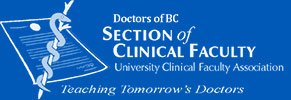What is the Section of Clinical Faculty?
The Section is a vital part of the Doctors of BC (formerly BCMA) and represents the interests of over 3,000 Physician clinicians who provide part-time teaching of Medical Students and Residents in conjunction with patient care. The Section was created in 2007 and given official recognition by the BCMA Board. It carries on the work of an affiliated professional society, the University Clinical Faculty Association, that was created in 1999.
The Section of Clinical Faculty is British Columbia’s only independent organization representing and supporting Clinical Teachers to provide the best care to their patients and the best training to Medical Students and Residents.
Why Do Clinical Faculty Need Representation?
Roughly two-thirds of the instruction needed to turn a medical student into a doctor is in the hands of Clinical Faculty. Clinical teaching takes place when practicing physicians mentor Medical Students and Residents in the care of the sick and injured. British Columbia is alone among Canadian provinces in the extent to which its university Faculty of Medicine depends so heavily on Clinical Faculty to provide this teaching.
The Section of Clinical Faculty and Doctors of BC continue to support expansion of the UBC Faculty of Medicine to increase the output of doctors by “making the whole province into a classroom”. However, to be successful Clinical Faculty need support for the following reasons:
Excellent Teaching takes time. It takes a finite amount of time to teach the technique of history taking and the subtle points of the physical exam. It takes a finite amount of time to teach a student how to sort through a differential diagnosis and to set clinical priorities. A significant amount of time is needed to train basic surgical technique, performance of procedures, and complex operations. Dealing with multiple patients at once is the final, time-consuming aspect of clinical training.
Excellent patient care takes time. It takes a finite amount of time to move a patient, empathetically and safely, through any medical process. For a clinic visit or visit to a family doctor’s office a patient takes time from the waiting room through the examination room to discharge instructions home. For a surgical procedure a patient requires time for pre-op diagnosis, evaluation, and instructions, time in the operating room theatre and recovery room, and time in rehabilitation and discharge planning. A profoundly ill patient takes time being resuscitated in the emergency department, time in the intensive care unit, time on the hospital floor, and additional time in preparation for being discharged home.
The time needed for teaching and the time needed for patient care are additive. A family physician teaching a student can see fewer patients than without trainees. A surgeon with a trainee physician can perform fewer operations than without trainees. An emergency physician with trainees to supervise can triage, treat, and discharge fewer patients than without trainees.
Clinical Faculty need protected time to teach well.
Clinical Faculty need protected time to safely care for their patients.
Clinical Faculty need protected time for their own wellbeing.
KEY PRINCIPLES FOR THE FUTURE OF CLINICAL TEACHING IN BC
The Section supports the Principles published in 2005 by the UCFA in its report Teaching BC’s Doctors of Tomorrow: Our Commitment And Our Concern:
1) Provided it is properly managed, clinical teaching benefits Medical Students and Residents, since it is a vital part of their development as professionals; the University, since it enables the Faculty of Medicine to tap the vital skills and experience of a large group of physicians; and the individual physician, since it can be a stimulating and satisfying way in which to put something back into society. Teaching new doctors is crucial for the province and for the medical profession.
2) Doctors have a responsibility to teach the next generation of Doctors by giving Medical Students and Residents the benefit of their knowledge and experience while providing guided access to their patients. In parallel with this responsibility, government and the University have a responsibility to ensure appropriate resources are available to support Clinical Faculty.
3) If clinical training is to be sustainable, society must recognize that it comes at a cost to both doctors and patients. It costs patients because clinical teaching increases the time required for assessment and treatment, making waiting lists longer for consultations, diagnostic tests and surgery or treatment. It costs doctors by impacting, sometimes severely, their ability to manage their time efficiently. Efficient time management is vital to the doctor’s ability to manage his or her practice.
Failure to provide sufficient resources to Clinical Faculty for teaching will jeopardize the training of future generations of doctors in BC in the current model of medical training in BC.
